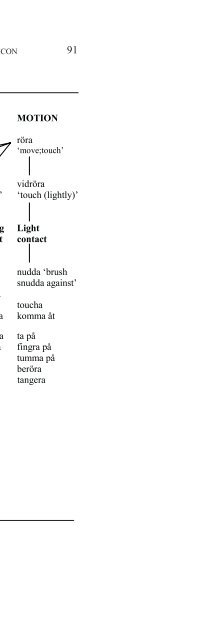Cognitive Semantics : Meaning and Cognition
Cognitive Semantics : Meaning and Cognition
Cognitive Semantics : Meaning and Cognition
You also want an ePaper? Increase the reach of your titles
YUMPU automatically turns print PDFs into web optimized ePapers that Google loves.
192 JORDAN ZLATEV<br />
2. Thus the picture at the bottom of Figure 1, which the system receives as input, should be<br />
described as, e.g., “The circle is above the rectangle.” not as “The rectangle is below the<br />
circle.”<br />
3. In Harnad’s “dualism” the connectionist/symbolic dichotomy roughly corresponds to<br />
perception/conception, while in the perhaps better known “hybrid” proposals of Pinker<br />
(e.g., Pinker <strong>and</strong> Prince 1988) the symbolic part is to model the “rules of language”, while<br />
the connectionist - the analogies. Harnad can be said to want to cut the cake horizontally,<br />
Pinker vertically.<br />
4. The difference in the training sets involving “go” <strong>and</strong> “fly” (somewhat arbitrarily decided<br />
on) was that the first but not the second involved contact between the objects.<br />
5. Note that it is not the technical aspect of “feed-forwardness” (nor the backpropagation<br />
learning rule) that is to blame, but the input/output interpretation of situations <strong>and</strong><br />
expressions. Instead situations <strong>and</strong> expressions should be treated in parallel, e.g., as they<br />
are in the “autoassociative” feed-forward system of Plunkett et al. (1992).<br />
References<br />
Anderson, R.<br />
1990 “Inferences about word meanings”. Inferences <strong>and</strong> Text Comprehension ed.<br />
by In A. Graesser & G. Bower. New York: Academic Press, 1-16.<br />
Bates, E. & Elman, J.<br />
1992 “Connectionism <strong>and</strong> the study of change”. Brain Development <strong>and</strong> <strong>Cognition</strong>:<br />
A Reader ed. by In M. Johnson, 623-642. Oxford: Blackwell Publishers.<br />
Chomsky, N.<br />
1959 “A review of Skinner’s Verbal Behaviour”. Language 35. 26-58.<br />
Chomsky, N.<br />
1971 Selected Readings, ed. by J.P.B. Allen & P. van Buren, Oxford: Oxford<br />
University Press.<br />
Dorffner, G.<br />
1989 A sub-symbolic connectionist model of basic language functions. Dissertation,<br />
Indiana University, Computer Science Department.<br />
Dorffner, G. & Prem, E.<br />
1993 “Connectionism, symbol grounding, <strong>and</strong> autonomous agents”. 15th Annual<br />
Meeting of the <strong>Cognitive</strong> Science Society Symposium on “Grounding,<br />
Situatedness, <strong>and</strong> <strong>Meaning</strong>”. Boulder, June 1993.<br />
Dreyfus, H.<br />
1991 Being-in-the-World. A Commentary on Heidegger’s “Being <strong>and</strong> Time,<br />
Division I”. Cambridge, Mass: MIT Press.<br />
Edelman, G.<br />
1992 Bright Air, Brilliant Fire, On the Matter of the Mind. New York: Basic<br />
Books, Harper Collins Publications.















